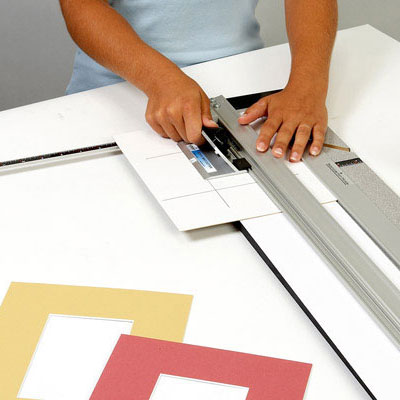GLAZING YOUR ARTWORK
"Glazing" is the framer's way of saying that you're putting glass over the artwork; and it would suffice to say just that except that sometimes you don't use glass, you use acrylic. Acrylic, the clear, unbreakable plastic often referred to by the brand name Plexiglas, has several advantages over glass that make it desirable in certain circumstances.
The primary advantage of acrylic is how lightweight it is. When your frame is larger than 24"x 36", it's wise to opt for acrylic. The difference in weight is remarkable and glass is dangerous to handle in such large sizes. Acrylic has the added advantage of being virtually unbreakable; so if you need to ship your artwork, acrylic is the better choice. On the other hand, acrylic scratches easily and must be cleaned with a soft cloth and plastic cleaner. Moreover, acrylic carries a high static charge and is risky to use with loose media like pastels and charcoals.
Acrylic usually comes covered with a protective mask. If you are reducing acrylic to size from a larger sheet, you can size it with the protective mask on, but when you are ready to clean it, peel away the mask from both sides (Figure Y-1). As the mask comes off, it will cling to the surface, betraying the static charge. Choose a plastic cleaner that has an anti-static agent (Figure Y-2) and then take it a step further by investing in an anti-static brush.
To clean acrylic, spray one side and wipe it down with a soft cloth. Avoid using paper towels as they can cause light surface abrasions in acrylic. As long as your plastic cleaner contains an anti-static agent, you can wipe the surface dry before turning it over to clean the other side. After cleaning both sides, use the anti-static brush to further reduce the static charge (Figure Y-3).
When cleaning glass, apply glass cleaner liberally to one side and then wait a few moments, letting the solvents in the cleaner break down dirt and oils (Figure Y-4). Wipe the glass, but avoid wiping it completely dry. Leave it moist and let it air dry the rest of the way. The action of wiping a paper towel across the dry surface of glass increases static charge and is one reason why dust and lint suddenly reappear inside the glass after you've carefully inspected it to be sure it's free of such nuisances. The other reason for the sudden appearance of dust and lint is the bellows effect created when you press down on the framing components as they are loaded into the frame (Figure Y-5). Pressing down and releasing the components creates a suction that draws dust, lint and paper scraps into the air space between the glazing and the artwork. To prevent this, seal the edges of the stack of framing components with white artist's tape or acid-free masking tape before loading them into the frame (Figure Y-6).
The term "glazing" refers to both glass and plastic. Glass Can be purchased by the lite (single sheet) or by the box from glass and mirror shops, art supply and craft supply stores, picture framers and hardware stores. Glass can be cut to size at some of these stores, or larger sizes can be bought and cut to size at home.
While glazing provides valuable protection to framed art, it is important to keep the glass away from the surface of the art. Ordinary humidity changes can cause artwork pressed against the glazing to stick to the glazing, and the lack of airspace can promote the formation of mold as moisture gets trapped in the frame. Use mats or other spacers in the framing to lift the glazing from the surface of the art.
REGULAR CLEAR GLASS
This is ordinary window glass. Picture framing glass is thinner, and flawless, although window glass may be used. Regular glass allows clear viewing of framed items at any depth, although there may be problems with glare.
NON-GLARE GLASS
This is clear glass etched or texturized to minimize reflections. Non-glare glass can cause viewing distortion when placed at a distance from artwork or objects.
UV-FILTERING GLASS
Also called conservation glass, this glass filters ultraviolet light rays, which are harmful to art. It is not a complete shield, and even with it, art should still be protected from too much light exposure.
PLASTIC
Plastic is about half the weight of glass, so it is a good choice for large frames or for children's play areas. Do not use plastics on pastels or charcoal drawings because the static of the plastic will lift particles off the art paper.
Acrylic is the best plastic for picture framing. It is sometimes available in standard sizes from frame shops or art supply stores. For other sizes, it can be purchased customcut to size from a glass supplier, or large sheets can be purchased and cut as needed. Use a sturdy thickness, such as 1/8". Acrylic usually comes with paper sheeting attached to both sides. Leave this protective paper on as long as possible. Styrene is a cheaper type of plastic; it yellows over time from exposure to heat and light.



HARD AND FAST: GLASS VERSUS PLEXIGLASS, WHICH IS BETTER?
The question of what's better, glass or acrylic, wants a hard and fast answer. One or the other. Black or white. Unfortunately, it's not like that. When it comes to the proper glazing for picture framing, both glass and acrylic have their advantages and disadvantages. Sometimes glass is preferred, sometimes acrylic is advisable. It depends on the situation.
When most people think of acrylic, often referred to as Plexiglass, the first thing that comes to mind is durability. Compared to glass, acrylic is virtually unbreakable, which makes it a must-have any time the framed piece is likely to be moved around a lot, and an absolute necessity whenever the piece is to be shipped. If any of the major carriers (UPS, FedEx, DHL) break the glass in a framed piece and ruin the artwork, they will likely NOT reimburse the market value of the artwork. (They may deem this a subjective value and argue that you could assign any value your little heart desires.) They may offer to reimburse nothing more than the value of the items used to create the artwork; ie, the paint, the paper and the glass. To avoid this infuriating slight, use acrylic when shipping artwork.
Yet, having said that, in at least one sense acrylic is more fragile than glass. Acrylic is easily scratched. Even just rubbing a crumpled up paper towel across the surface of acrylic can result in light surface abrasions. For this reason, you must use a soft cloth when cleaning acrylic, either a cotton rag or a specially constituted paper towel like a Scott Wyp-All, which has the texture and feel of cotton. In addition, you must use plastic cleaner to clean acrylic, never glass cleaner. All of which makes acrylic more complicated to clean than glass.
But there is some good news when it comes to cleaning acrylic. When you first buy it, acrylic doesn't need to be cleaned. Acrylic is typically sold with a protective plastic or paper mask over it. When you peel away the mask, the acrylic is as clean as it's ever going to be. This is quite different than what you experience with glass. Glass purchased at retail establishments like paint and glass stores or home improvement centers is almost universally filthy when you buy it. Not only does it require cleaning, it requires repeated and rigorous cleaning if you want any hope of using it.
All that cleaning has other implications as well. Unbeknownst to most framers, wiping a dry paper towel repeatedly across the surface of glass builds up static charge. Static charge is the culprit that causes dust and lint to cling to the inside of your glass. If you've ever had the experience of inspecting a glazed and framed piece prior to putting it into a frame, finding it suitably free of dust and lint, and then loading and securing it into the frame only to discover, upon turning it over, that there are dust particles clinging to the inside of the glass, static charge is the problem. To eliminate it, either avoid wiping the glass to dry - leave it moist and let it dry the rest of the way on its own – or, better yet, invest in an anti-static brush. Brush the glass once with the anti-static brush to eliminate the static charge before loading the glass into the frame.
In case you're thinking that using acrylic will avoid problems with static charge, think again. When it comes to static charge, acrylic is worse than glass. In fact, static charge is the single biggest drawback to using acrylic in framing. Using acrylic untreated will cause you no end of frustration. So strong is the static charge in acrylic that it will lift the pastel dust right off a pastel and it will lift charcoal dust from a charcoal drawing. Fortunately, however, the problem is easily solved. When you are using acrylic, always use an anti-static brush right after you remove the protective mask. This will take out the static charge without requiring you to clean the acrylic, a process that seems unnecessary given the fact that the acrylic is already clean when you buy it.
Now that we've addressed the single biggest drawback to acrylic, we should address its single biggest benefit. Compared to glass acrylic is remarkably lightweight. With larger pieces, say 24"x36" and larger, glass can be dangerously heavy, causing the frame to bow under the weight. Not only that, but glass can be downright treacherous to carry in those larger sizes, threatening to flex and snap. With larger sizes acrylic is preferred.
But the troublesome fragility of glass gives it at least one distinct advantage over acrylic. Glass is relatively easy to cut. All you typically need to do to reduce glass to size is to score it once or twice with a glass cutter and snap it cleanly along a sharp edge. With acrylic you are in for an altogether different experience, particularly if the acrylic is close to the 1/8" thickness considered standard for picture framing. Even after scoring repeatedly with an acrylic cutter, the acrylic may not be ready for a clean snap, and you will not know for sure until you try, and if you guess wrongly and try too soon, the acrylic will snap jagged and be ruined. The problem is less severe the thinner the acrylic you use, but if you use acrylic that's a good deal less than 1/8" thick, you run the risk that it looks plasticky, in other words, cheap.
Many framers who use acrylic prefer to work in standard sizes so they don't have to struggle with sizing it, but this is something you need to plan for ahead of time. Long story short, it can require more advanced planning to use acrylic, but for a variety of other reasons it may be worth it.
There are pros and cons to both glass and acrylic. Depending on the situation one may be preferred over the other. But a cut and dried endorsement of one over the other in all cases would not be wise. There is no hard and fast answer.












